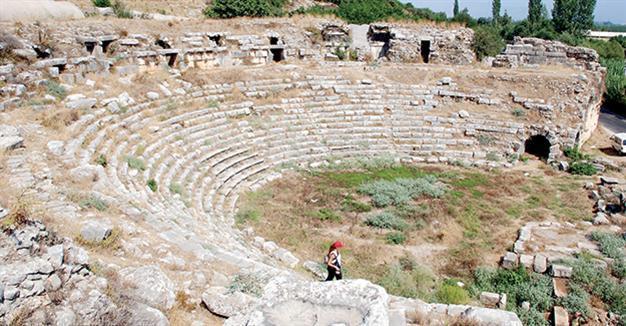Archaeology season opens in Antalya
ANTALYA – Doğan News Agency

DHA photo
Archaeological excavations in the southern province of Antalya will start this month in 15 different spots, including ancient cities, caves and mounds.Antalya was home to the ancient cities of Lycia and Pamphylia, which include traces from the Paleolithic age.
2016 is also the 66th year of archaeological excavations in Xanthos, which is one of 15 Turkish sites on the UNESCO World Heritage List. Initiated in 1950 by French archaeologists, works have been carried out by Akdeniz University since 2011.
Excavations that have been continuing in the ancient city of Patara, the birthplace of Apollo, are also entering their 28th year. Excavations on the site were conducted by Professor Fahri Işık between 1988 and 2008 but have been under the direction of Professor Havva Işık since 2009, during which time an ancient city was unearthed.
This year, excavations at the Santa Claus Museum, the most popular tourist attraction in Antalya, will be headed by Hacettepe University. Elsewhere, works in the ancient city of Myra, which started in 2009, will be carried out by Mediterranean University.
Excavations in Finike, Kumluca, Kemer
The ancient city of Limyra, which is situated on the skirts of a 1,216-meter-high mountain in Finike, has been hosting excavation teams from the Austrian Archaeology Institute for 45 years.
The most unique feature of the Limyra excavations, the “Limyra of Children” program, will enter its fifth year. The program aims to teach children about their historical heritage with various workshops, and children joining the program will have the chance to visit museums and excavation sites, see historical structures and learn about ancient times.
Following 10 days of activities, children will present their knowledge in events like theater, music and 3D shows.
Another excavation area in Finike is Arykanda, situated on the Elmalı-Finike highway, close to the Arif village’s Aykırıçay neighborhood. Works will be conducted by Hacettepe University there this year.
Excavations that started in 2006 in the ancient city of Rhodiapolis, which was discovered in 1982 by Austrian archaeologists and is home to an ancient Greek inscription, will be headed by the Antalya Museum this year.
The ancient city of Olympos will host teams from Eskişehir’s Anadolu University while Akdeniz University will conduct works in ancient Phaselis, located near Kemer.
One of Turkey’s biggest natural caves, the Karain Cave, was discovered in 1946 in Antalya’s Döşemealtı district by Professor Kılıç Kökten. The cave is an important Paleolithic center in terms of the history of Anatolia and the Near East. Works will be carried out by Ankara University in the cave this year.
Perge excavations turn 70
This year, excavations in the ancient city of Perge started in February and turned 70. The first work was commenced in the city in 1946 by Professor Arif Müfid Mansel and is now carried out by the Antalya Museum.
Mansel also conducted excavations in the ancient city of Side starting in 1947, while Anadolu University will continue digging in the city this year.
The ancient city of Antiocheia ad Cragum in Gazipaşa, where a 2,000-year-old Roman mosaic was unearthed last year by Selçuk University, will host a team headed by Nebraska University.
Also, Bilkent University’s İlknur Özgen will head excavations at the Hacımusalar mound in Elmalı.
















